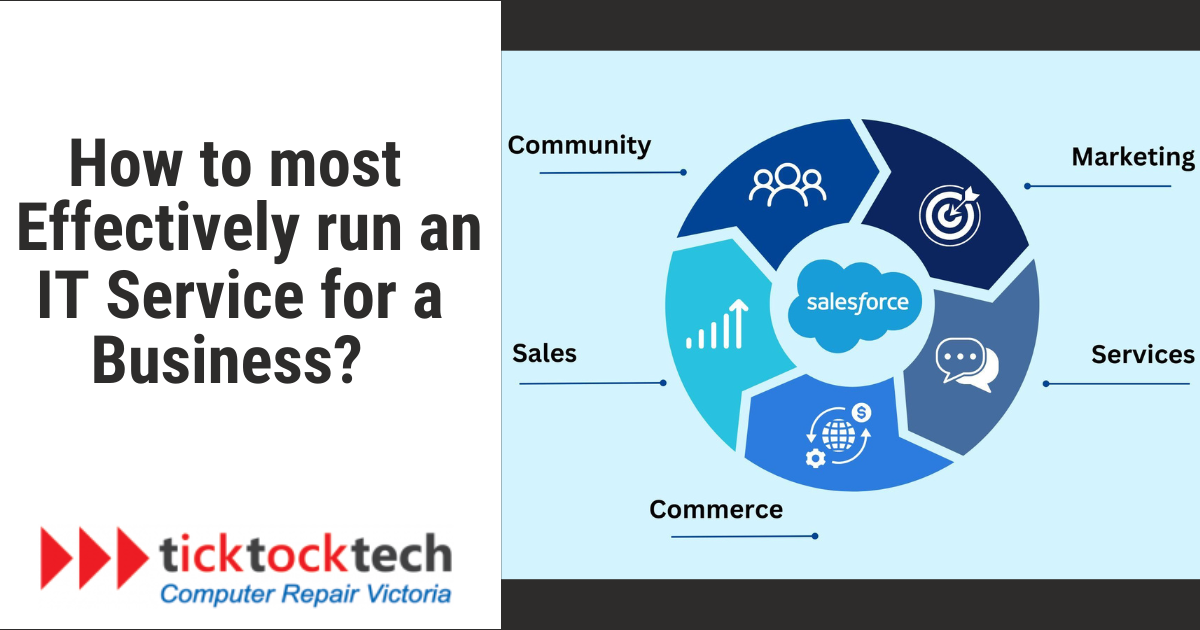A well-run IT service is crucial for the success and expansion of any corporation in the fast-paced and fiercely competitive business environment of today. Creating an IT strategy is an organization-wide effort and it’s well worth the investment which helps in achieving long-term vision. The optimization of processes, improvement of production, and protection of data all depend heavily on information technology. Businesses must put into place efficient plans and procedures if they are to realize the full potential of IT. How to most effectively run an IT service for a business?
When running IT like a company, IT must consider business value and outcomes rather than activities and stuff when thinking and acting. Businesses require a trustworthy and dependable technology partner because technology is used in every aspect of businesses today and will continue to grow. In the end, companies need a technology partner who thinks like a business and not like “techies”. This means that if they want to continue to be that company’s technology partner in the future, many IT firms will need to alter their strategy. IT must operate independently.
Running IT service for a business must start from a strong foundation
You can’t even think of running an IT service for a business unless you do the following three things:
- You excel at the fundamentals: email must be dependable, PCs must function, and systems must be steady and efficient.
- You are knowledgeable about your industry and the role that technology plays in it.
- You’re thinking right, but you can’t just wait until someone asks. You need to take the initiative and advertise how technology can grow the company.
We’ll look at important guidelines and advice in this post to assist you in running an IT service for your businesses as efficiently as possible.
1. Match IT to business objectives
Aligning your IT service with your business objectives is the first and most important step in managing it successfully. IT service should be incorporated into the overall business plan rather than existing in a separate silo. To bring this alignment about:
- Maintain consistent communication between IT and other departments to learn about their requirements and difficulties.
- Set IT goals that directly support the mission and vision of the firm.
- Create a thorough IT plan that describes how technology will boost corporate efficiency and growth.
It is simpler to defend investments and show stakeholders the benefit of IT services when IT goals and plans are in line with more general company objectives.
2. Strengthened IT service governance
A successful IT service is built on effective IT governance. Ensuring that IT resources are utilized effectively and safely, entails establishing roles, responsibilities, and processes. IT governance’s essential elements include:
- Clearly defined policies and procedures: Consistency and responsibility must be ensured by having written rules for IT operations, security, and compliance.
- Risk management: Through proactive steps and disaster recovery plans, identify and reduce potential threats to IT systems and data.
- Transparency: Clarity on why and how decisions are made
- Empowerment: Individuals and teams are empowered to make the right decisions, which is critically important in the “always connected, always on” digital era.
- Focus: Identifying what is most important so that individuals and teams can take action to deliver on the organization’s mission, vision, and goals.
- Compliance: Make sure your IT service adheres to all applicablelaws and industry standards, such as GDPR, HIPAA, or ISO 27001.
- Performance monitoring: Evaluate IT service performance regularly to spot potential areas for development.
Ultimately, good governance is the way to protect the reputation of the business, promote the values and principles of the organization, and, at the same time, ensure the value of what the business is delivering to the customer.
3. Invest in skilled personnel
Your IT team’s abilities and knowledge are crucial to the success of your IT service, so hire strategically. Make certain to:
- Recruiting and retaining top talent: Employ experts with the knowledge and practical expertise needed to operate your IT infrastructure efficiently. Give them continuing education to keep their skills current.
- Foster a collaborative environment: Encourage information exchange and teamwork within your IT staff to foster a collaborative environment. Innovative problem-solving and solutions can result from collaboration.
- Outsourcing: When it makes sense for your company, look into contracting out specific IT operations, such as cybersecurity or cloud management, to specialized service providers.
- Cross-training: To enable faster operations and efficient problem-solving, make sure team members have a thorough understanding of various IT domains.

4. Adopt cloud computing
With its scalability, flexibility, and cost-effectiveness, cloud computing has completely changed the IT environment. Businesses can save infrastructure costs, increase accessibility, and improve disaster recovery capabilities by adopting cloud solutions. Implementing cloud services involves:
- Carefully assess your company’s requirements and select the best cloud option (public, private, or hybrid).
- Cooperate with trustworthy cloud service providers to guarantee data security and compliance.
- Create a migration plan that causes the least amount of disturbance and optimizes the cloud’s advantages.
You may optimize IT operations and enable remote work by moving to the cloud, which is beneficial in the modern company environment.
5. Prioritize cybersecurity
- Due to the complexity and sophistication of cyber threats, cybersecurity is of utmost importance to enterprises. To safeguard your IT system and sensitive information:
- Put in place a multi-layered security approach that uses antivirus software, intrusion detection systems, and firewalls.
- Perform frequent vulnerability assessments and security audits to find and fix any potential flaws.
- Inform staff members on cybersecurity best practices to lower the possibility of human error and phishing scams.
To lessen the effects of security breaches and ensure a quick recovery, you should also think about putting in place a strong incident response plan.
6. Regular upkeep and modifications
The systems and technologies of today will be the legacy systems and technologies of tomorrow. Therefore, IT has to always have an eye on the technology horizon because it won’t see what’s coming if it’s always looking inward. Business is always evolving. Technology is always evolving. IT systems must be updated and maintained regularly to be effective, secure, and compatible with emerging technology. Make certain to:
- Plan frequent system updates and patches to fix flaws and enhance performance.
- Maintain hardware and software regularly to avoid unexpected breakdowns.
- Keep tabs on your software licenses to verify compliance and stay out of trouble with the law.
Having a proactive approach is crucial since neglecting maintenance can result in expensive downtime and security breaches.
7. Evaluation and tracking of performance
IT service performance must be continuously monitored and analysed to spot problems and areas for development. You don’t have to wait until an issue arises. Key performance indicators (KPIs) can be used to gauge:
- System availability and uptime.
- Response times for essential services and applications.
- Network activity and bandwidth usage.
- User contentment with IT services.
Review performance data frequently, using it to influence decisions and alterations to your IT service.
8. Budgeting
Adequate financing is necessary to operate a successful IT service. Make a sensible IT budget that provides for:
- Compensation and training for employees.
- The acquisition of new hardware and software.
- The price of compliance and security measures.
- Subscriptions to cloud services.
To make sure resources are being used effectively and your IT budget is in line with your company objectives, evaluate it frequently.
FAQs on How to most effectively run an IT service for a business?
Aligning IT with business goals ensures that technology investments and strategies directly contribute to the organization’s success. It helps prioritize IT initiatives and demonstrates the value of IT services to stakeholders.
Communication is crucial for understanding the needs of different departments, aligning IT with business goals, and ensuring that IT initiatives meet the expectations of stakeholders. Regular communication fosters collaboration and helps in delivering value through IT services.
Staying adaptable involves staying informed about emerging technologies and trends, seeking continuous improvement opportunities, and being open to adjusting IT strategies as needed to meet evolving business needs.
Conclusion
Operating an IT service for a company is a challenging and diverse task but it is necessary to effectively run a business. However, you can create an efficient IT service that promotes business success by integrating IT with business objectives, enacting strict governance, investing in qualified personnel, embracing cloud computing, prioritizing cybersecurity, conducting routine maintenance and updates, monitoring performance, and using your budget sensibly. Remember that technology is constantly changing, therefore it’s crucial to be versatile and constantly look for ways to get better in the fast-paced world of IT services.
Overall, managed IT services can be a strategic investment that not only saves costs but also enhances the efficiency, security, and competitiveness of your business. The specific benefits will depend on your business’s unique needs and the services provided by your chosen managed IT service provider.

